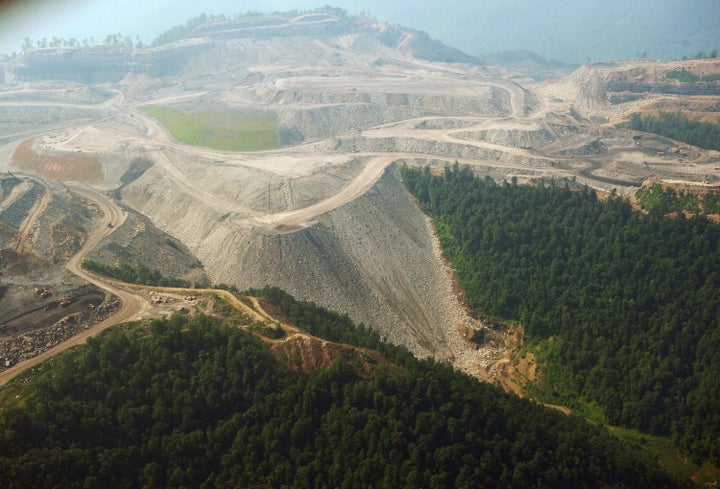
Like many people, I am drawn to stories about heroes. But my taste is not entirely conventional. Superheroes or comic strip heroes or celebrities who do the ordinary but have publicists to paint it as heroic don't work for me. I'm drawn to tales of average Joes, made out of the same rough clay as you and me, who are forced to battle Goliaths. In The Last Mountain, I share my discovery of such folk in the hollows and valleys of America's Appalachian Mountains.
Geologically, the Appalachian range is an ancient band of mountains that stretches in a sweeping arc from the Canadian province of Newfoundland down through the eastern United States. Culturally, the heart of Appalachia lies in the states of Kentucky, Tennessee, Virginia and Pennsylvania, but there is no state more connected with Appalachia than West Virginia. And though Appalachia is prized for its songwriters and storytellers, its sweet fresh water, its wide ribbons of diverse and its dense forest and its strong sense of community, at the heart of its economic life has long been coal.
Give or take, about half of the electricity of the United States comes from the burning of coal, and 30 percent of this coal is blasted out of the mountains of Appalachia. Think to yourself -- every time you power up your iPod or your microwave, flick a light on over your child's bed or watch a baseball game played under the lights -- nearly half the energy you're using comes from burning rock chiseled and blown from the American landscape. And while the benefits of this coal-powered electricity are readily apparent to us all, there are great, if unseen, costs as well.
Some of these costs include brain damage in as many as 600,000 newborn children a year, north of 40,000 premature deaths and around 10,000,000 asthma attacks each year. Add to this the mercury contamination of more than a million miles of rivers and all the freshwater fish in the United States and the proliferation of leaking sludge and ash pits containing hundreds of billions of gallons of toxic waste at mine sites and power plants across the country and the often uncounted costs of burning coal start to swell. Chip in with the fact that the mining and burning of coal is also the biggest source of anthropogenic greenhouse gases in the world -- and no matter what one thinks about the virtually unanimous concern scientific leaders share about this, it's hard not to feel that conducting a science experiment with the only planet in the known universe that supports human life is a bit scary. The more one knows, the more one wonders about how good an idea all this coal burning is after all.
But in the heart of Appalachia, in the steep walled valleys and amidst the once rich streams of the Coal River Valley, the costs of mining coal rise higher still. Here, a horrendous assault on the natural world was unleashed during the George W. Bush administration. In a shrouded regulatory maneuver, the administration legitimized a medieval mining practice called mountaintop removal, and a widespread, explosive-heavy war on the mountains of Appalachia stormed forth. Detonating the power of a Hiroshima bomb every day on Appalachian landscapes, mining corporations have obliterated 500 mountains, permanently eliminated more than 2,000 miles of rivers and streams, and laid waste to more than one million acres of forest -- an area close to the size of Delaware. Perhaps more importantly, the poisonous aftermath of this form of chemical warfare has sickened children, contaminated drinking water supplies and shattered communities that thrived for generations.
Standing up to battle the mining companies' greed-fueled onslaught has been the most unlikely team of Americans. Housewives and waitresses, former marines and former miners, AARP members, academics and college students from across the country have joined together to build a new energy future for their community, and for all of us. Enduring physical attacks and emotional intimidation, they have been arrested for peaceful protests in their governor's office, they have strapped themselves by the neck to mining equipment and engaged in frigid winter tree-sits near mine sites laced with explosives. With hundreds of folks arrested for acts of civil disobedience in the past few years alone, and having now enlisted a river of public-spirited and celebrated Americans to their cause, the folks of the Coal River Valley are taking their place at the forefront of other heroic movements in the annals of American consciousness raising. Think Selma. Think Concord.
Stories of heroes like these, ordinary Americans like Maria and Bo, Ed and Antrim, Judy and Larry, Joe and Jack and Gus and Jennifer and countless others -- people who take great personal risk for the betterment of their communities, and for ours -- these are the tales that bring me to the edge of my seat, that illuminate and inspire and engage me, that move me to stand up and be counted. These are the stories of The Last Mountain.
